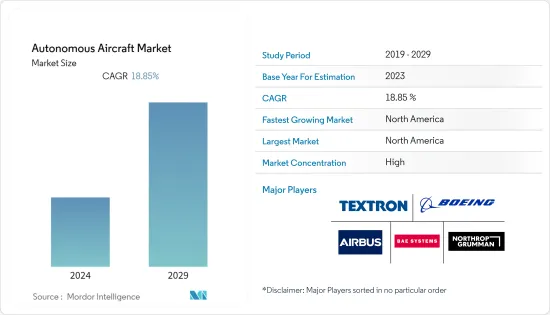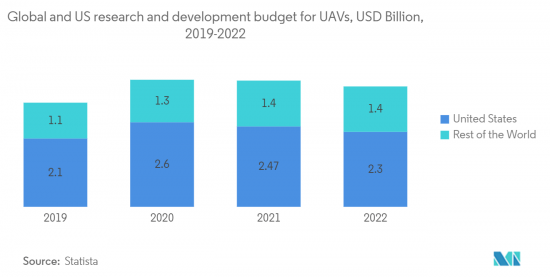 |
市場調査レポート
商品コード
1404519
自律型航空機- 市場シェア分析、産業動向・統計、2024~2029年の成長予測Autonomous Aircraft - Market Share Analysis, Industry Trends & Statistics, Growth Forecasts 2024 - 2029 |
||||||
● お客様のご希望に応じて、既存データの加工や未掲載情報(例:国別セグメント)の追加などの対応が可能です。 詳細はお問い合わせください。
| 自律型航空機- 市場シェア分析、産業動向・統計、2024~2029年の成長予測 |
|
出版日: 2024年01月04日
発行: Mordor Intelligence
ページ情報: 英文 110 Pages
納期: 2~3営業日
|
- 全表示
- 概要
- 目次
自律型航空機市場は、2024年に104億7,000万米ドルと評価され、予測期間中のCAGRは18.85%で成長し、2029年には248億2,000万米ドルに達すると予測されています。

この市場を牽引しているのは、効率的で安全な輸送に対するニーズの高まり、人工知能やセンサー技術の進歩、軍事用途における無人航空機(UAV)の需要拡大など、さまざまな要因です。また、政府や非公開会社による研究開発活動への投資が増加していることも市場の追い風となっています。
既存の空域システムへの自律型航空機の統合に関連する規制上の課題は、市場の成長を妨げます。さらに、自律型航空機のコストが高いことや、この分野でより熟練した専門家が必要であることも、その他の阻害要因となっています。結論として、自律型市場は予測期間中に成長する計り知れない可能性を秘めています。
自律型航空機市場の動向
自律型貨物機は予測期間中に市場シェアの急成長が見られる
この自律型航空機技術を最初に採用するのは貨物機と予想されます。旅客機では、安全性と人命が最重要視されるため、自律型航空機の採用は継続的で厳格なテストが行われた後に開始されるはずです。貨物機での自律型航空機の使用では、人命リスクのレベルはゼロであるため、これは貨物機の場合とは異なります。さらに、eコマース産業の成長が航空貨物需要を牽引しており、近い将来、航空貨物パイロットの需要が高まる可能性があります。
自律型航空機市場における開発のほとんどは、パイロット不足によるギャップを埋めるために、自律型貨物機を商用化することを目的としています。 例えば、2023年5月、Xwingは米国空軍からパイロットレス貨物試験を行う契約を獲得しました。契約条件に従って、Xwingは空軍や軍の利害関係者と自律飛行の最適な使用事例の特定を調整します。また、セスナ208Bプラットフォームでの自律飛行を可能にするため、飛行制御システム、自動離着陸、探知・回避(DAA)システム、自動ブレーキ、自動タクシー、遠隔操作ソフトウェアの融合を含む試験飛行を実施します。このような開発は現在数多く進められており、今後10年以内に自律型貨物機が市場に導入されることが期待されています。

北米は予測期間中も市場シェア優位を維持する見込み
北米は現在、この地域での戦術自律型無人航空機の調達数が多いため、自律型航空機市場で最高の市場シェアを誇っています 現在、米国は自律型航空機の開発にますます注力しています。自律型航空機の利用は、民間航空分野における現行の規制枠組みのために若干後退しているもの、軍事分野における自律型航空機の持続的な研究開発が市場成長を牽引しています。米国のような国々で高い技術進歩が、状況の変化に適応し、人間の介入なしに飛行状況を処理できる高度な自律型航空機の開発につながっています。例えば、2022年12月、米国国防総省はスカイボーグ・プログラムの一環として、F-16ジェット機VISTA X-62Aの自律飛行を17時間以上テストしました。テスト・シミュレーションでは、AIが操縦するVISTAジェット機が戦闘機操縦技能と模擬ドッグファイトに従事し、AIは人間のパイロットを上回った。スカイボーグ・プログラムは、米国空軍の目標である無人戦闘機の開発推進の一環として、2019年に開始されました。また、米国軍は2022年11月にブラックホークヘリコプターの初飛行試験を行った。ロッキード・マーティンは2021年12月のテストに先立ち、VISTAジェット機の「モデル・フォロー・アルゴリズム」(MFA)と「シミュレーションの自律制御システム」(SACS)のアップデートを提供しました。
将来的には、自律型航空機は航空貨物業務にも広く採用されることが想定されています。このため、いくつかの研究開発プロジェクトが開始され、自律型航空機のエコシステムへの新規参入が促進されています。例えば、2023年7月、自律飛行のためのソフトウェアを開発する貨物航空会社の新興企業であるリビットは、カナダ運輸省およびカナダ革新的ソリューションズと130万米ドルの契約を結び、遠隔地での自動飛行航空機の試験を開始しました。同社は2人乗りの飛行機で200時間以上のハンズフリー飛行を完了し、商業サービスに向けて運用テストを急速に進めています。同社はカナダ運輸省に対し、1機の航空機と遠隔地の乗組員およびメンテナンス・サービスを提供し、自律的な貨物飛行を1年間維持する予定です。カナダ運輸省はまた、このデータを活用して将来の航空規制、基準、政策に役立てています。
自律型航空機産業の概要
自律型航空機市場はまだ発展途上であるため、The Boeing Company、Airbus SE、Northrop Grumman Corporation、Textron Inc. (Bell Helicopters)、BAE Systems plcといった一握りのプレーヤーが、特に防衛分野で市場シェアを独占しています。しかし、自律型航空機市場でテストされている技術のほとんどは、すでにUAV業界の設計標準となっています。したがって、旅客機や貨物運搬用途の革新的な開発という尺度では、まだ後れを取っています。
とはいえ、耐久性など、UAVと比較した場合、自律型航空機にしかない固有の能力もあります。この点に関して、Northrop Grummanは2021年9月、航続距離3,000マイルを誇るモデル437と名付けられた新しい自律型航空機の設計を発表しました。同社はScaled Composites社と提携し、米国空軍の戦力増強につながる可能性のある航空機を設計しました。比較的新しいコンセプトは、市場に参入するプレーヤーに多くのチャンスをもたらしています。例えば、2021年10月、Textron Aviationは、現在および将来の航空機のための自律飛行機能を開発するために、Xwingと独占的パートナーシップを締結しました。Textron AviationとXwingは現在、Textronのセスナ・グランド・キャラバン実用機用の遠隔操縦技術を開発しています。同様に米国では、DARPAのANCILLARYプログラムが、長時間飛行、垂直離着陸(VTOL)性能に必要な重要技術を備えた小型無人航空システム(UAS)の開発と飛行実証を目指しています。
その他の特典
- エクセル形式の市場予測(ME)シート
- 3ヶ月間のアナリスト・サポート
目次
第1章 イントロダクション
- 調査の前提条件
- 調査範囲
第2章 調査手法
第3章 エグゼクティブサマリー
第4章 市場力学
- 市場概要
- 市場促進要因
- 市場抑制要因
- ポーターのファイブフォース分析
- 供給企業の交渉力
- 買い手・消費者の交渉力
- 新規参入企業の脅威
- 代替製品の脅威
- 競合の敵対関係の激しさ
第5章 市場セグメンテーション
- 航空機タイプ
- 固定翼
- 回転翼
- 用途
- 貨物機
- 旅客機
- エンドユーザー
- 商業
- 防衛
- 地域
- 北米
- 米国
- カナダ
- 欧州
- 英国
- フランス
- ドイツ
- イタリア
- ロシア
- その他欧州
- アジア太平洋
- 中国
- インド
- 日本
- 韓国
- その他アジア太平洋地域
- ラテンアメリカ
- ブラジル
- メキシコ
- その他ラテンアメリカ
- 中東・アフリカ
- サウジアラビア
- アラブ首長国連邦
- トルコ
- 南アフリカ
- その他中東とアフリカ
- 北米
第6章 競合情勢
- ベンダー市場シェア
- 企業プロファイル
- Northrop Grumman Corporation
- The Boeing Company
- Lockheed Martin Corporation
- RTX Corporation
- Elbit Systems Ltd.
- AeroVironment, Inc.
- Saab AB
- BAE Systems plc
- Airbus SE
- Textron Inc.
- IAI
第7章 市場機会と今後の動向

The autonomous aircraft market was valued at USD 10.47 billion in 2024 and is projected to reach USD 24.82 billion by 2029, registering a CAGR of 18.85% during the forecast period.
The market is driven by various factors, including the increasing need for efficient and safe transportation, advancements in artificial intelligence and sensor technologies, and the growing demand for unmanned aerial vehicles (UAVs) in military applications. The market also benefits from the rising investments by governments and private companies in research and development activities.
The regulatory challenges associated with the integration of autonomous aircraft into existing airspace systems hampers market growth. Additionally, the high cost of autonomous aircraft and the need for more skilled professionals in the field are some of the other restraints. In conclusion, the autonomous market has immense potential for growth in the forecasted period.
Autonomous Aircraft Market Trends
Autonomous Cargo Aircraft to Witness Rapid Market Share Growth During the Forecast Period
Cargo planes are expected to be the first to adopt this autonomous aircraft technology. In passenger flights, safety and the lives of people are given paramount importance, and thus, the adoption of autonomous aircraft should start after continuous and rigorous testing is done. This is not the case with cargo aircraft, as the level of life risk is zero with the use of autonomous aircraft in cargo planes. Additionally, the growth in the e-commerce industry is driving the air cargo demand, which may increase the demand for air cargo pilots in the near future.
Most of the developments in the autonomous aircraft market are aimed at bringing autonomous cargo aircraft into commercial use to fill in the gap due to the pilot shortage. For instance, in May 2023, Xwing was awarded a contract by the US Air Force to conduct pilotless cargo trials. As per the terms of the contract, Xwing will coordinate the identification of best use cases for autonomous flight operations with the Air Force and military stakeholders. Also, Xwing will conduct test flights that include a fusion of flight control systems, auto takeoff/landing, Detect-and-Avoid (DAA) systems, auto braking, auto taxi, and remote operations software to enable autonomous operations on the Cessna 208B platform. Many such developments are currently underway, and these are expected to help autonomous cargo aircraft be introduced into the market within the next decade.

North America is Expected to Continue its Market Share Dominance During the Forecast Period
North America currently has the highest market share in the autonomous aircraft market due to the high number of procurements of tactical autonomous UAVs in the region. Currently, the US is increasingly focused on the development of autonomous aircraft. Though the usage of autonomous aircraft has witnessed a slight setback due to the current regulatory framework in the commercial aviation sector, persistent R&D in the military sector for autonomous aircraft has been driving market growth. Technological advancement, which is high in countries like the US, has led to the development of advanced autonomous aircraft, which can adapt to changing conditions as well as handle flying situations without any human intervention. For instance, in December 2022, as a part of the Skyborg Program, the US DoD tested the autonomous F-16 jet VISTA X-62A for more than 17 hours of autonomous flight. In the test simulation, the VISTA jet operated by AI engaged in fighter maneuver skills and simulated dog fights, and AI outperformed the human pilot. The Skyborg Program was initiated in 2019 as part of a drive by the US Air Force goal to develop unmanned combat aerial vehicles. The US military also tested the first flight of a Black Hawk helicopter in November 2022. Lockheed Martin provided 'model following algorithm' (MFA) and a 'system for autonomous control of the simulation' (SACS) updates for the VISTA jet prior to testing in December 2021.
In the future, autonomous aircraft are also envisioned to be adopted on a wide scale for air cargo operations. This has encouraged several R&D projects to be initiated and has fostered the entry of new players in the autonomous aircraft ecosystem. For instance, in July 2023, Ribbit, a cargo airline startup developing software for autonomous flight, signed a USD 1.3 million contract with Transport Canada and Innovative Solutions Canada to begin testing self-flying aircraft in remote regions. The company has completed over 200 hours of hands-free flight on a two-seat airplane and is rapidly advancing operational testing in preparation for commercial service. The company will likely provide Transport Canada with a single aircraft along with remote crew and maintenance services to sustain autonomous cargo flights for one year. Transport Canada will also leverage this data to help inform future aviation regulations, standards, and policies.
Autonomous Aircraft Industry Overview
The autonomous aircraft market is still incubating and hence is consolidated in nature as a handful of players such as The Boeing Company, Airbus SE, Northrop Grumman Corporation, Textron Inc. (Bell Helicopters), and BAE Systems plc dominate market share, especially in the defense sector. However, most of the technologies being tested in the autonomous aircraft market are already the design standards in the UAV industry. Hence, it still trails in the measure of innovative developments in passenger and cargo-carrying applications.
Nevertheless, there are certain inherent capabilities exclusive to autonomous aircraft when compared to UAVs, such as endurance. On this note, in September 2021, Northrop Grumman unveiled the design of a new autonomous aircraft named Model 437, with a 3,000-mile range. The company has partnered with Scaled Composites to design the aircraft as a potential force multiplier for the US Air Force. The relatively new concepts are opening many opportunities for players to venture into the market. For instance, in October 2021, Textron Aviation entered an exclusive partnership with Xwing to develop autonomous flight capability for its current and future aircraft. Textron Aviation and Xwing are currently developing remote piloting technology for Textron's Cessna Grand Caravan utility aircraft. Similarly, in the US, the DARPA's ANCILLARY program aims to develop and flight demonstrate a small unmanned air system (UAS) with the critical technologies required for long endurance, vertical takeoff, and landing (VTOL) performance.
Additional Benefits:
- The market estimate (ME) sheet in Excel format
- 3 months of analyst support
TABLE OF CONTENTS
1 INTRODUCTION
- 1.1 Study Assumptions
- 1.2 Scope of the Study
2 RESEARCH METHODOLOGY
3 EXECUTIVE SUMMARY
4 MARKET DYNAMICS
- 4.1 Market Overview
- 4.2 Market Drivers
- 4.3 Market Restraints
- 4.4 Porter's Five Forces Analysis
- 4.4.1 Bargaining Power of Suppliers
- 4.4.2 Bargaining Power of Buyers/Consumers
- 4.4.3 Threat of New Entrants
- 4.4.4 Threat of Substitute Products
- 4.4.5 Intensity of Competitive Rivalry
5 MARKET SEGMENTATION
- 5.1 Aircraft Type
- 5.1.1 Fixed-wing
- 5.1.2 Rotary-wing
- 5.2 Application
- 5.2.1 Cargo Aircraft
- 5.2.2 Passenger Aircraft
- 5.3 End-user
- 5.3.1 Commercial
- 5.3.2 Defense
- 5.4 Geography
- 5.4.1 North America
- 5.4.1.1 United States
- 5.4.1.2 Canada
- 5.4.2 Europe
- 5.4.2.1 United Kingdom
- 5.4.2.2 France
- 5.4.2.3 Germany
- 5.4.2.4 Italy
- 5.4.2.5 Russia
- 5.4.2.6 Rest of Europe
- 5.4.3 Asia-Pacific
- 5.4.3.1 China
- 5.4.3.2 India
- 5.4.3.3 Japan
- 5.4.3.4 South Korea
- 5.4.3.5 Rest of Asia-Pacific
- 5.4.4 Latin America
- 5.4.4.1 Brazil
- 5.4.4.2 Mexico
- 5.4.4.3 Rest of Latin America
- 5.4.5 Middle East and Africa
- 5.4.5.1 Saudi Arabia
- 5.4.5.2 United Arab Emirates
- 5.4.5.3 Turkey
- 5.4.5.4 South Africa
- 5.4.5.5 Rest of Middle East and Africa
- 5.4.1 North America
6 COMPETITIVE LANDSCAPE
- 6.1 Vendor Market Share
- 6.2 Company Profiles
- 6.2.1 Northrop Grumman Corporation
- 6.2.2 The Boeing Company
- 6.2.3 Lockheed Martin Corporation
- 6.2.4 RTX Corporation
- 6.2.5 Elbit Systems Ltd.
- 6.2.6 AeroVironment, Inc.
- 6.2.7 Saab AB
- 6.2.8 BAE Systems plc
- 6.2.9 Airbus SE
- 6.2.10 Textron Inc.
- 6.2.11 IAI
